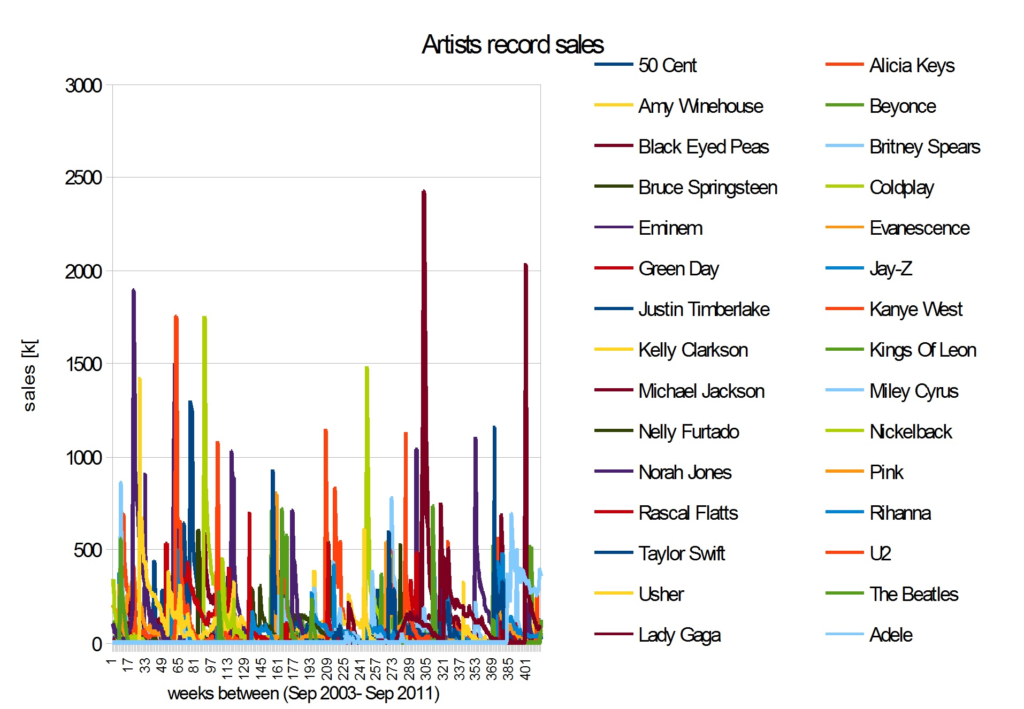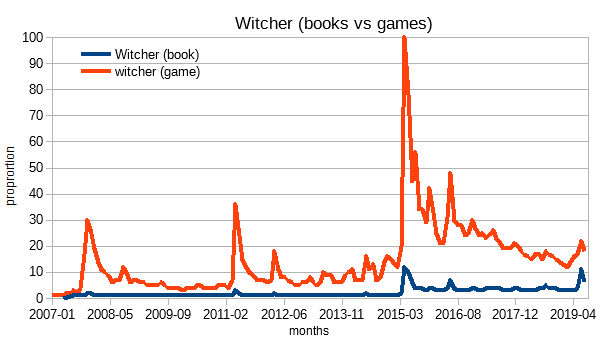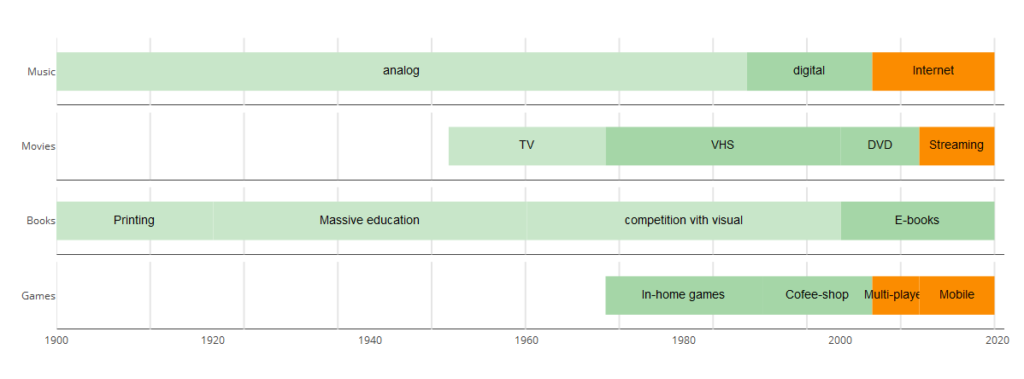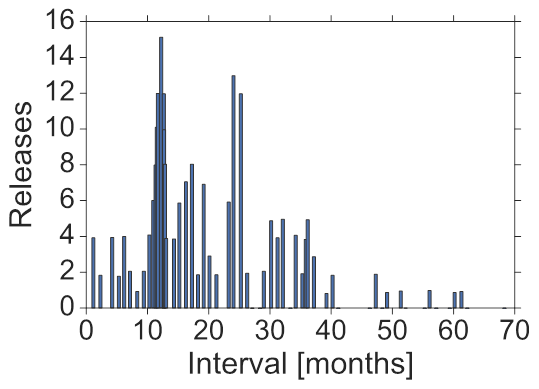Andrzej Buda 1 , Andrzej Jarynowski 1,2, Vitaly Belik 2
1 Interdisciplinary Research Institute, Wrocław/Głogów, Poland
2 Institute for Veterinary Epidemiology and Biostatistics, Freie Universität Berlin, Germany
Presented at E-methodology conference, Wrocław, 2019
We analyze temporal dynamics of entertainment industry including literature, music, films and video games. We focus on music and extend our research to other parts of entertainment industry under the influence of technological revolutions, introducing possible analogies between them. Music industry analysis is based on subsequent albums sales time series by artists from statistical point of view, including networks of artists, record labels and producers. The statistical properties of the entertainment industry (including value of the markets, seasonality, products life-cycles) and possible interferences between different parts of this industry under influence of the Internet era are also discussed.
Introduction and motivation
Entertainment industry has always been devoted to human basic needs since ancient times. The Nine Muses of the Greek Mythology have given an inspiration to artists, philosophers and individuals for creation. This culture has accompanied humans on their journeys through life. The people themselves have created cultural trends and established businesses to satisfy the demand for culture and influencing the economy. Therefore, cultural products have acted as a means for giving a cultural voice to people – consumers (Cebula, 2013).
In the present paper we discuss four branches of entertainment industry: books or literature, films or motion pictures, songs and video games. In the digital era, computational and statistical methods dedicated to digital traces of human participation in culture (e.g. Big Data) via so called distant reading (Moretti, 2013), (Jarynowski, Buda, Paradowski, 2019), are becoming more and more popular. The whole field of digital humanities has emerged (Eder, et al., 2013). Based on empirical data, we present several use cases of statistical and quantitative analysis of the historical data from the above mentioned entertainment fields. In particular we demonstrate similarities in the evolution of those fields.
In the XVth century literature experienced a dramatic upsurge due to invention of earlier printing methods by Gutenberg resulting in the Bible becoming the bestselling item of all time. The biggest element of the global entertainment industry belongs to books (value estimated ~143 billion US dollars (Publishing Standards, 2017)), because books are still able to involve in formal education at school or after school in adult life. Even the emergence of innovations by Thomas Edison and Lumiere brothers in phonographic and motion picture industry of XIXth century or videogames in XXth century did not change it. There was a rise of novels between 18th and 20th century (Moretti, 2013) – first in Europe and the last in Africa.
The domination of books has been developed traditionally in the past, and is still unscathed, despite the Internet era. However, the number of novels in each country increased in different periods. The stability of domination in books sales is often based on books series (e.g. Harry Potter or The Lord Of The Rings, etc.) that may serve as inspiration for directors creating movies. Remakes are important part of the US motion picture industry (StephenFollows, 2018).
The motion picture industry is worth at least 43 billion US dollars according to the latest annual reports (Lpesports, 2018). However, on the Internet era, the contribution of remakes (including prequels, sequels, etc. (Loocks & Verevis, 2012) in the total number of movies decreases (StephenFollows, 2018) over the last 120 years of Hollywood. A movie or books series are the main products traded on these markets with their own fan base.
On the other hand, in music industry, artists could be considered as a product traded in phonographic market because they all signed contracts with record companies. Their subsequent albums may be compared to remakes in motion picture industry and books or video games series (Fig. 1).
In music industry, the role of film director or book author may be played by record producers who initially were a sound engineer only. However, digital technologies had impact on the art of sound creation and even deceased artists are able to “record” new music or put their holograms on well-paid live tours. Therefore, record producers are as much important as directors in film industry or authors for books. In book industry, direct communication perspective between author via narratives (Moretti, 2011) and reader (Jarynowski, Boland, 2013) is very important, so the role of editor is smallest in all creative industries
Product Life-cycle
Relationship between agents in creative industry can be described by Actor-Network Theory (Latour, 2004). Creative market could be represented as a set of players (artists) managed by their companies – labels/studios/publishers, who sell products to customers. Sizes of the markets are limited, and the creative items are characterized as luxury goods in economic sense. Companies and their artists are supposed to establish the optimal selling strategy. They can control many factors like release date, strength of promotion and items quality. From the economical point of view, we define an artist, film series (even in a single movie a bunch of people are involved as actors directors, producers, writers, composers), book series and game series as a product. Empirical observations (Fig. 1) show that album sales of an artist (product) reach maximum exactly in the first week of new item (album) release. Companies often set album release dates (tuning inter-event times and exact release date) according to potential high sales, which is defined as an area under the sale curve (Fig. 1). Of course, companies are going to counteract this decrease by promotional events (in music industry singles can be released, in books authors readings are useful, etc.).

Source: Own graph
We observe symbiotic inference between various creative industries, mainly around books (as Harry Potter movie/book -interfered life cycle of book sales together with film released. and Witcher book/game (Fig. 2)). The Nielsen Company is monitoring such interactions.

Creative industry revenues
Artists gets salary depending on the signed contract and companies (publisher/studio/label) make business on them. Success of the creative product can be measured in many ways such as critics opinion, chart position, popularity in media, etc. Monetary outcome is prioritized in this article, due to its quantitative character (even it is biased as overrepresenting high-income populations). E.g. the evolution of revenues of three creative industries (Movies, Games, and Music) was analyzed in Ref. (Lpesports, 2018) and a trigging point was revealed (around 2005), when Games revenues exceeded Music and Movies revenues.
The value of video games industry – estimated to be $109 billion – consists of mobile gaming – $46 billion, smartphone games – $35 billion, tablet games – $11 billion, console gaming – $33 billion, digital content – $22 billion, physical sales – $11 billion and PC gaming – $29 billion. Despite these new technologies, books market (including e-books) is still the biggest one – $143 billion (Source: Publishing Standards, 2017) and music industry – $30 billion (including $15 billion because of physical records) and motion picture industry – $98 billion (including $27 billion from the global Box Office, DVDs & blue rays – $41 billion and TV copyrights – $17 billion) seem to be outnumbered. In music industry streaming revenue is 47% of global total and yearly growth in paid streaming revenues: +33% (IPFI, 2019).
According to annual reports, the largest gaming markets of 2017 were in China – $36 billion, United States – $25 billion, Japan – 201 billion, and European Union – $20 billion (Source: Vgames, 2018). On the contrary, the US and European markets dominate in music industry. According to the IFPI more than 90% of the total revenue of music in 2018 was derived from the 30 major countries with dominance of USA, Japan and UK and almost neglectable position of China (IFPI, 2019). Books sales major markets are similar to music (dominating countries are still USA and Europe (Statista, 2019A)). However, cinema tickets sales major markets (China is just behind USA) are more similar to video games (Statista, 2019B).
Eras
In history culture evolved in time (Batist, 2011). New genres come to live, merge, and die. Fashion trends are dynamic (Lorenz-Spreen, et al., 2018), (Cebula, 2013). Device and technology drive revolutional transition in culture (Buda, Jarynowski, 2015b), (Jara-Figueroa, et al., 2019), (Hidalgo, 2015).
These four industries could be divided in general in three Eras due to technological changes:
• pre digital with a dominant role of broadcasting technology and physical supply chain of device;
• digital with digital mean of devices and shortened transporting time (Schneider, et al., 2011);
• post digital with streaming technologies and on demand content.
In detail the following chronology:

Source: own graph
In entertainment/culture consumption models, we need to consider individualistic consumption (more specific) and tribal consumption (more fashion driven) (Castells, 2011), (Cebula, 2013). In post digital era, for example attending, cinema or concert – social facts are both declining, while video games and streaming on device (individual action) are growing.
There problem of piracy has interfaced selling distributions unequal according to countries industries and given products. Digitalization of devices and Internet sharing of resources gave an opportunity for piracy. Current approach of creative companies as cloud storing (e.g., Amazon kindle), streaming technologies (e.g. Netflix), or external licence management (e.g. Google Play) decreases piracy size. Let consider China case. This country is leading in term of videgames sells (with ~30% of global share) and second in books (~10%) and movies (~15%) markets. However, China almost does not exist on phonographic market (less than 1% of global share (IFPI, 2019)). Cultural difference cannot explain such a difference, so music industry is the most vunerable for piracy.
Current time series of album sales in music (as well as in other creative industries) differ from classic product life-cycles (Stark, 2004) because album sales usually reach their maximum in the first week after premieres (Fig. 1). However, historical time series are similar to standard life-cycle (Rogers, 1965) due to gaining popularity via information diffusion by physical devices (Buda, Jarynowski, 2015b). There are, moreover, symptoms of sales increase one week before the peak because of pre-orders in the Internet era (the same effect can be seen for Harry Potter movie/book. From the marketing (Thomas, 2006) point of view (Fig. 1), on the Internet era (2003-2013), the global phonographic market is over-represented by innovators, early adopters and early majority (Rogers, 1965). Other participants (including customers that are laggards or late majority) are not entirely affected (their seasonal impact may be explained well by stochastic models (Jarynowski, Buda, 2013)). Moreover, an observation of seasonality of items sale (increase of album release late autumn and early winter) is universal (Fig. 4) (Chrismas “madness”). It means that customers wallets approach is crucial to understand that phenomena (after Christmas and New Year Eve people might have less money for such a luxurious good like a creative items). Monthly global video games sales between 2013 and 2018 is increasing with similar seasonal patterns (CNB, 2019).

Interevent time is defined as a time between the release of a new item (it could be a new record of an artist, new book in series etc). In general it is increasing with time. We have analyzed 30 most popular artists album sales trajectories that depend on intervals between consecutive albums premieres (Fig. 5) and found out 2 characteristic time intervals: 1 and 2 years.

Analogies between books, movies, music and video games creative markets
Creative industries are characterized by some common properties:
- Creative market as a predictable system – in complexity and in particular for a record/movie/book/game;
- Creative industry might be considered as a programmable system – agents as record, studios, editors optimaze profits ;
- Even unpredictable popularity spread by the Internet do not break the equillibrium (Jarynowski, Buda, 2013) on the market (for example virals as Gangman style in music or Farmville in games);
- The system might be unstable in case of artists death only for music and book industry;
- There is a strong seasonality, there are fans that buy records/DVDs/books/games every month and occasional clients who buy items just before Christmas;
- There is a decreasing trend in selling physical devices of record/movie/book/game which characterize the creative markets all over the world and an increasing trend in streaming or digital copies (itunes, lastFM, Netflix, Kindle store, google play, etc);
- The trajectory of items sales has a pick on the release day and decreases exponentially (Fig. 1) with some additional peaks caused by promotion including tours, author meetings, competition etc;
- In the past, the peak of item sales has appeared a few weeks after the release, and sales have decreased slowly, but currently the peaks of item sales appear in the first week after the release;
- Popularity spreads both via cultural and geographical paths (Jarynowski, Buda, 2016);

These predictable results obtained for music industry might be extended to other data sets. For instance, for the last 120 years of Hollywood movies history, over 6000 films with the corresponding remaking formats (ca. 1700 original films) and ca. 4300 films of various remaking formats) were collected (Loovk& Verevis, 2012). The distribution of intervals between subsequent remakes seems to be multimodal probably like in the music industry (Fig. 5). Moreover, the number production of remakes by studios increases since the beginning of 20th Century and collapses in the year 2005. It means that the Internet era has forced some studios to integrate with others or be eliminated for good. Thus, the number of remakes decreased significantly after 2005. The same process takes places in the music industry when small labels become a part of major labels. Moreover, music and the motion picture industry has the same participants (Universal, Warner, Columbia, etc.). Therefore, since the beginning of the 21th century, the number of major labels has decreased to those four. On the contrary, the value of video games market increases year by year since the early ’80s.
Tab. 1 Analogies between the four main parts of the global entertainment industry
| Books (B) | Films (F) | Music (M) | Video games (V) | |
| Economic product | series | remakes | artists (Fig.6) | series |
| Economic company | author | director | producer | producer |
| Economic distributor | publisher | studio | label | studio |
| Product life-time, agents: predigit | very many pubs | many studios | 2 years interv many labs | few studios |
| Product lif-time agents: digit | many pubs | few studios | 1 year interv many labs | many studios |
| Product life-time agents: postdigit | very many pubs (selfpublishing) | few studios | 1.5 year interv few labs | few studios |
| Inference- predigit | F | B | B | B |
| Inference- postdigit | V | V | V | B |
According to annual reports, books are still the greatest and the most valuable part of entertainment industry. On the Internet era, number of book publishers increases, but the number of distributors decreases. Number of record labels remains constant, but number of distributors decreases. Number of film studios (and connections between studios creating different remakes) increases till 1990’s but in the Internet era (2005) it collapses. In Post-Digital Age (called Internet in music) small companies (labels) are forced to merge or look for non-record related new sources of revenue (Galuszka, Wyrzykowska, 2016).
Summary
Such analogies within the most profitable 4 parts of the global entertainment industry may define networks of entities (Tab. 1) represented in a universal way and detect the importance of the technological eras in the evolution from historical and economic point of view. In our contribution, we present the results of quantitative analysis for music records and several results or analogies with other parts of entertainment industry. Such quantitative and distance reading approaches promise to provide deep insights into dynamics of entertainment industry and even to develop predictive models for e.g. revenues. All of these 4 industries changed their characteristics due to Internet (Tab. 1), (Fig. 3).
Moreover, all these entertainment industries may interact with each other because of overlapping fanbase. For example, Lara Croft is the most successful human videogame character according to the Guinness Book of Records because she has extended her ‚activity’ from Tomb Raider videogame series to comics, novels, television, films and soundtracks albums (featuring famous names like Graeme Revell or Alan Silvestri). On the other hand, The Lord Of The Rings and Harry Potter series, with their origin in books, have become interactive and universal too. Star Wars movies have inspired a lot of people to fill the gaps between consecutive series by creating books and videogames that have been later authorized by George Lucas. Even the Beatles fans may have occasion to participate in creating new version of classic songs because of XBOX or jam together with other musicians online. There are examples of interference among all four creative markets. The Witcher (originally Polish book series) has gather international attention in Books, Video Games and recently in Movie Industry. However, The Witcher music records gather attention only in Poland (golden record in 2002). Despite blurred boundaries, the economy behind all the main branches of entertainment industry remains invariant. Therefore, analogies between main branches of entertainment industry may be detected and unified as multilayer network elements (cultural dynamics, globalization, commodity market, etc.).
Acknowledgement
This research was supported by COSTNET (CA15109).
Literature
Babtist JM, et al., (2011) Quantitative analysis of culture using millions of digitized books, Science, Nr 331 (6014), 176–182.
Ball, P. (2004) Critical Mass – How One Thing Leads to Another („particles become people”), New York: Farrar, Straus and Giroux.
Buda, A. and Jarynowski, A. (2010) Lifetime of Correlation and its applications. Wroclaw: WN.
Buda, A. (2012) Does pop music exist? Hierarchical structure in phonographic market, Physica A: Statistical Mechanics and its Applications 391 (21), 5153-5159
Buda, A. and Jarynowski, A. (2015A) Exploring patterns in European singles charts, Network Intelligence Conference (ENIC), 135-139
Buda, A. and Jarynowski, A. (2015B) The global phonographic market: record labels, artists and fans in the internet era, E-methodology 2, 96.
Castells, M. (2011) The rise of the network society: The information age: Economy, society, and culture. Vol. 1. John Wiley & Sons.
CNB (2019) Video games seasonality. Retrieved Mai 20, 2019, from https://www.cnbctv18.com/market/data/video-game-sales-are-extremely-seasonal-1511161.h
Cebula, M. (2013). Społeczne uwarunkowania gustów i praktyk konsumpcyjnych. Zbieżność pozycji społecznych i stylów życia czy autonomizacja kultury?. Studia Socjologiczne, 209(2), 97-125.
E-book comments (2010), August Ebook Sales, Retrieved Mai 20, 2019, from http://ebookcomments.blogspot.com/2010/10/august-ebook-sales.html
Eder, M., Kestemont, M., & Rybicki, J. (2013). Digital Humanities 2013: Conference Abstracts.
Fandom (2017) Video game industry, Retrieved Mai 20, 2019, from https://vgsales.fandom.com/wiki/Video_game_industry
Galuszka, P., & Wyrzykowska, K. M. (2016). Running a record label when records don’t sell anymore: empirical evidence from Poland. Popular Music, 35(1), 23-40.
Inceoglu, F., & Park, M. (2011). Diffusion of a new product under network effects: the US DVD market. Applied Economics, 43(30), 4803-4815.
IFPI (2019) IFPI Global Music Report 2018 Retrieved Mai 20, 2019, from https://www.ifpi.org/news/IFPI-GLOBAL-MUSIC-REPORT-2019
Jara-Figueroa, C., Amy, Z. Y., & Hidalgo, C. A. (2019). How the medium shapes the message: Printing and the rise of the arts and sciences. PloS one, 14(2), e0205771.
Jarynowski, A., & Boland, S. (2013). Rola analizy sieci społecznych w odkrywaniu narracyjnej struktury fikcji literackiej. Biuletyn Instytutu Systemów Informatycznych, 35-42.
Jarynowski, A (2014). Obliczeniowe nauki społeczne w praktyce. Wrocław: WN.
Jarynowski, A., & Buda, A. (2014) Dynamics of popstar record sales on phonographic market – stochastic model, Acta Physica Polonica B (PS) 2 (7), 2014.
Jarynowski, A., & Buda, A. (2016). Diffusion paths between product life-cycles in the European phonographic market. Control and Cybernetics, 45(2).
Jarynowski, A., Buda, A., Paradowski MB. (2019) MODELLING COMMUNITIES AND POPULATIONS. INTRODUCTION TO COMPUTATIONAL SOCIAL SCIENCE (accepted to Methodological Studies)
Latour, B. (2005). Reassembling the Social: An Introduction to Actor-Network-Theory. Oxford ; New York, Oxford University Press.
Loock, K., & Verevis, C. (Eds.). (2012). Film Remakes, Adaptations and Fan Productions: Remake/Remodel. Palgrave Macmillan.
Lpesports (2018) Video games vs music and movie industries. Retrieved Mai 20, 2019, from https://lpesports.com/e-sports-news/the-video-games-industry-is-bigger-than-hollywood
Lorenz-Spreen, P., Wolf, F., Braun, J., Ghoshal, G., Conrad, N. D., & Hövel, P. (2018). Tracking online topics over time: understanding dynamic hashtag communities. Computational social networks, 5(1), 9.
Moretti, F. (2011). Network Theory, Plot Analysis, New Left Review, Nr 68, 1–64.
Moretti, F. (2013). Distant reading. Verso Books.
NetworkDataScience (2017) The Effect of Luck, Skill and Collaboration in Success and Careers, Retrieved Mai 20, 2019, from https://networkdatascience.ceu.edu/node/330
NetworkDataScience (2019) Quantifying and Comparing Success in Creative Careers, Retrieved Mai 20, 2019, from https://networkdatascience.ceu.edu/node/519
Nilsen Company (2010) ‘Deathly Hallows’ film Breathes Life into Harry Potter Book Sales. Retrieved Mai 20, 2019, from https://www.nielsen.com/us/en/insights/article/2010/deathly-hallows-film-breathes-life-into-harry-potter-book-sales/
Pabjan, B. (2010). The Reception of Chopin and His Music in Polish Society. International Review of the Aesthetics & Sociology of Music, 41(2).
Percino, G., Klimek, P., & Thurner, S. (2014). Instrumentational complexity of music genres and why simplicity sells. PloS one, 9(12), e115255.
Publishing standards (2017) Global book market valued at $143bn Retrieved Mai 20, 2019, from https://thenewpublishingstandard.com/global-book-market-valued-at-143bn/
Rogers, EM. (1962). Diffusion Of Innovations (1st ed.). New York: Free Press of Glencoe
Stanisz, T., Kwapień, J., & Drożdż, S. (2019). Linguistic data mining with complex networks: a stylometric-oriented approach. Information Sciences, 482, 301-320.
Statista (2019A). Share of the total sales of the global book publishing market in 2017, by country. Retrieved Mai 20, 2019, from https://www.statista.com/statistics/288746/global-book-market-by-region/
Statista (2019B). Box offices. Retrieved Mai 20, 2019, from https://www.statista.com/statistics/243180/leading-box-office-markets-workdwide-by-revenue/
Stark J, (2004) Product Lifecycle Management: 21st Century Paradigm for Product Realisation, Springer, ISBN 978-1-85233-810-7.
Stephen Follows (2018) Remakes. Retrieved Mai 20, 2019, from https://stephenfollows.com/the-prevalence-of-sequels-remakes-and-original-movies
Schneider, C. M., Belik, V., Couronné, T., Smoreda, Z., & González, M. C. (2013). Unravelling daily human mobility motifs. Journal of The Royal Society Interface, 10(84), 20130246.
Thomas Jr, G. (2006). „Building the buzz in the hive mind”. Journal of Consumer Behaviour 4 (1): 64–72. doi:10.1002/cb.158.
Vgames (2018). Video games industry Retrieved Mai 20, 2019, from https://vgsales.fandom.com/wiki/Video_game_industry
Ꮋeya i am for the first time here. I found this board and I in finding It really helpful & it helped me out much.
I’m hoрing to give something back and heⅼp otһers such as you helped me.